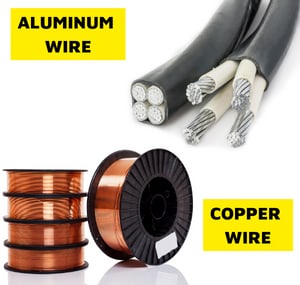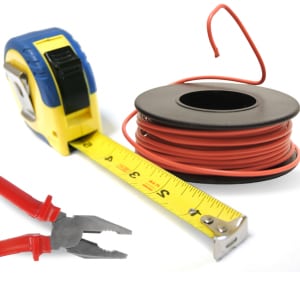4 gauge wire can carry high current. It is commonly used in automotive and marine applications, as well as for some industrial and residential electrical wiring. How many amps can a 4 gauge wire handle depends on factors such as the length of the wire, the type of insulation, and the ambient temperature.
4 gauge copper wire at 140⁰F has a current rating of 70 amps in a raceway, in a cable, or when directly buried, and has a rating of 105 amps in free air. 4 gauge aluminum wire will have lower current ratings.
Table of Contents
Maximum Current Rating or Ampacity of 4 Gauge Wire
As we mentioned earlier, the maximum amperage a 4 gauge wire can carry depends on various factors. Notable ones are the material and the length of the wire, the type of insulation, the ambient temperature, and the application.
Wire material and insulating materials are the most important factors when rating 4 gauge wires. We will discuss the two factors in detail in the succeeding section, but we’ve listed the current ratings from the US National Electric Code below. Aside from the two, we’ve listed other factors for you to consider:
1. Wire material
Here is a summary of the current ratings comparing two of the most common material for 4 gauge wires, copper and aluminum.
These are based on the NEC’s wire gauge amp chart at 140⁰F, 167⁰F, and 194⁰F in free air and in a raceway, cable, or direct burial with not more than 3 current-carrying conductors.
|
4 AWG ampacity at Different Temperatures |
||||||
| Wire material | Copper | Aluminum or copper clad aluminum | ||||
| Temperature | 140⁰F | 167⁰F | 194⁰F | 140⁰F | 167⁰F | 194⁰F |
| Insulation | TW and UF | Include RHW, ZW, XHWN, and USE among others | Includes PFA, SIS, TBS, XHHW-2 and ZW2 among others | TW, and UF | Includes RHW, ZW, XHWN, and USE among others | Includes PFA, SIS, TBS, XHHW-2 and ZW2 among others |
| Current rating of wire a raceway, cable or direct burial with not more than 3 current carrying conductors | 70 amps | 85 amps | 95 amps | 55 amps | 65 amps | 75 amps |
| Current rating of a wire in free air | 105 amps | 125 amps | 140 amps | 80 amps | 100 amps | 115 amps |
2. Wire length
Wire length does not change a wire’s current rating. However, 4 AWG wire used for long distances may be limited by a voltage drop due to the wire’s additional resistance. The NEC recommends a limit of 3% voltage drop to minimize equipment performance issues.
Here is a summary of the maximum length you may use at different temperatures and wire materials for conductors in a raceway, cable, or direct burial with not more than 3 current-carrying conductors. They are listed at 12V and at 24V DC, as well as at 120V and at 240V AC:
|
Maximum wire length of 4 gauge wire at different voltages |
||||||
| Wire material | Copper | Aluminum or copper clad aluminum | ||||
| Maximum current and Temperature | 70 amps
140⁰F |
85 amps
167⁰F |
95 amps
194⁰F |
55 amps
140⁰F |
65 amps
167⁰F |
75 amps
194⁰F |
| 12 volts | 8.5 feet | 7 feet | 5.9 feet | 6.5 feet | 5.5 feet | 4.5 feet |
| 24 volts | 17 feet | 14 feet | 12 feet | 13 feet | 11 feet | 9 feet |
| 120 volts | 89 feet | 70 feet | 59 feet | 69 feet | 55 feet | 46 feet |
| 240 volts | 178 feet | 140 feet | 118 feet | 138 feet | 110 feet | 92 feet |
3. Different 4 AWG cables
A lot of 4 gauge wires are seen in the form of multi-conductor cables. These cables have multiple insulated 4 gauge wires in a sheath. Examples of these are 4/2 cables (cable with two 4 gauge current-carrying conductors) and 4/3 (cable with three 4 gauge current-carrying conductors).
For smaller wire sizes like 4 gauge wire, the current rating of a multi-conductor cable is generally the same as the current rating of a single conductor. For example, Southwire’s Romex 4/3 wire amp rating is the same as a single copper conductor – at 70 amps. The same can be extended to a 4/2 Romex amp rating.
4. For different applications
4 gauge wire can be used in a residential setting for high-powered appliances like electric heaters and furnaces. Most equipment at home is connected to a panelboard that is rated at 600 volts or less, so the wire ratings will be restricted to the 140⁰F current ratings even if these wires are rated for higher applications.
Also, take note that when the wire is used for continuous loads (like a refrigerator), the current rating will be reduced to 80% of the capacity of the wire. This is to account for heat that may otherwise affect the operation of the overcurrent protection device.
4 gauge wire is also used for wiring car amplifiers, RV connections, for marine applications like boats, and combining batteries to increase capacity. They usually come in the form of a 4 gauge wire amp kit and are made with either pure copper (oxygen-free copper, or OFC) or copper-clad aluminum (CCA).
How to Calculate Amps
If you cannot find numbers that satisfy your specific conditions on our list, you can easily calculate yours using an online calculator. These calculators have taken correction factors into account and can be modified based on the conditions you need.
Some calculations that you may be doing on your own would be the 80% limit for continuous loads. Simply multiply the 4 gauge wire amp rating in our tables by 80 %:
\[ \text{Current}_{80\% \text{ amps}} = 4 \text{ AWG rating} \times 0.80 \]
For example, 4 gauge copper wire has a rating of 70 amps in a residential conduit. The allowable current for continuous loads will be:
\[ \text{Current}_{80\% \text{ amps}} = 4 \text{ AWG rating} \times 0.80 \ = 70 \times 0.08 = 56 \text{amps}\]
Factors that Affect Wire Ampacity
The maximum amount of electrical current that a wire can safely carry is affected by several factors. We’ve arranged the factors from the most important to the least, respectively.
- Material: Different materials offer varying resistance to electrical current flow. For example, copper is a better conductor of electricity than aluminum, meaning copper wires can carry more current than aluminum wires of the same size.
- Insulation: The insulation used around the wire affects its ability to dissipate heat. The higher the insulation temperature ratings, the higher ampacity the wire can achieve.
- Temperature: Like insulation, the ambient temperature around the wire also affects its ability to dissipate heat. Higher temperatures can reduce the ampacity of a wire.
- Installation Methods: The way a wire is installed affects its ability to dissipate heat.
- Frequency: The frequency of the electrical current flowing through the wire can affect its ampacity. AC current has higher losses due to the skin effect and proximity effect.
Frequently Asked Questions
What is the difference between 4 gauge wire and other wire sizes?
The only thing that’s different with 4 gauge with the rest is its size. 4 gauge wire diameter is 0.2043″ (5.189 mm). Lower gauge numbers will be thicker while higher gauges will be thinner.
What happens if using too low or too high amps for 4 gauge wire?
In normal applications, no problems are encountered if you use too low of a current for a 4 gauge wire. In fact, using thicker wires reduces the voltage drop. The only drawback would be that 4 gauge wire is more expensive than 12 gauge wire (for example).
If the current is too high, though, then the insulating material might break down because of the excessive heat. Remember from our table that some materials can tolerate up to 140⁰F while others can tolerate up to 194⁰F.
Conclusion
4 gauge copper wire is normally used with a rating of 70 amps at 140⁰F and aluminum wire with a rating of 55 amps at 140⁰F. This is determined by the wire’s insulation and its use. Wire length does not really have an effect on wire rating.
We’ve provided the ampacity charts that showcase how many amps can a 4 gauge wire handle. These can help you plan the right electrical connection for your power-demanding equipment.

I am Edwin Jones, in charge of designing content for Galvinpower. I aspire to use my experiences in marketing to create reliable and necessary information to help our readers. It has been fun to work with Andrew and apply his incredible knowledge to our content.







